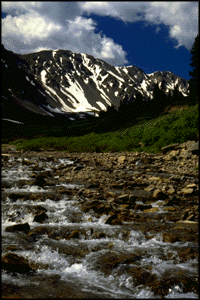September 24, 1995
“Climbing a fourteener,” that is, scaling one of Colorado’s 54 peaks above 14,000 feet, is a Monday-morning chant often heard around the water cooler in Denver. Successfully conquering a fourteener is a badge one brandishes in conversation, attesting to his or her recreational prowess. Yet as weekend warriors head to the hills to add another fourteener to their list of accomplishments, the mountains have paid a price. “Use has increased dramatically in the past 20 years,” said Dan Matthews, wilderness manager for the Aspen/Sopris district of the White River National Forest. “It’s a growing concern for us … how to handle this many people in a fragile environment.” Consequently, the Forest Service is spearheading a program, the Fourteener Initiative, to mitigate the onslaught on Colorado’s fourteeners. It’s possible, said Matthews, that some trails may eventually be closed off to hikers.
 Colorado’s fourteeners became newsworthy this summer when two Colorado men climbed all 54 in a record 15 days, 9 hours and 55 minutes. The accomplishment, which was covered extensively by the Denver media, reinforced the appeal of climbing fourteeners to the public. Summiting a 14,000-foot peak is a dramatic accomplishment, combining endurance, good health, strong legs and fortunate weather. Although the degree of difficulty varies widely from peak to peak, from easy to highly technical, the view and sense of self-esteem are both significant at 14,000 feet, regardless of the expertise needed to reach the summit. The opportunity to see mountain goats and/or bighorn sheep adds to the allure.
Colorado’s fourteeners became newsworthy this summer when two Colorado men climbed all 54 in a record 15 days, 9 hours and 55 minutes. The accomplishment, which was covered extensively by the Denver media, reinforced the appeal of climbing fourteeners to the public. Summiting a 14,000-foot peak is a dramatic accomplishment, combining endurance, good health, strong legs and fortunate weather. Although the degree of difficulty varies widely from peak to peak, from easy to highly technical, the view and sense of self-esteem are both significant at 14,000 feet, regardless of the expertise needed to reach the summit. The opportunity to see mountain goats and/or bighorn sheep adds to the allure.
But as more and more adventure seekers trek up fourteeners, the fragile high-alpine environment is taking a beating. Litter, erosion, improvised trailblazing, and disturbance of endangered plants and animals are all by-products of fourteener zeal. Some peaks, said Mary Beth Hennessy, U.S. Forest Service recreation planner, have one-quarter- to one-half-mile wide multiple trails to the summit. One of the objectives of the Fourteener Initiative is to establish one route for the masses to reach the summit.
Still another concern expressed by Matthews is the increasingly diminishing aspect of solitude in the high country. Designated wilderness areas (where many fourteeners are located) have been set aside to, in part, allow visitors to experience solitude in a natural setting. “People are not experiencing the solitude they should be experiencing in a wilderness setting,” said Matthews. For many visitors to the high country, said Hennessy, climbing a fourteener is “a social experience, not a reflective one.”
The climb up Grays Peak (above) recently was not an exercise in solitude. At least 70 cars were parked in the trailhead parking lot and the 4.3-mile trail to the summit was well populated with hikers. Young and old, families and individuals made the trek. Mountain goats, almost tame, greeted hikers at higher elevations. Grays’ proximity to Denver (less than 40 minutes via I-70) makes it one of the most popular fourteeners, but in spite of the crowd, one can’t deny the exhilaration of making those last few steps to the summit. At 14,270 feet, the 360-degree view from Grays encompasses Summit County, Lake Dillon, Longs Peak to the north and Pikes Peak to the south. Having scaled the relatively easy trail, the view empowers the climber in a strange way. Here, on one of the highest points on the continent, the splendor of the Colorado mountains is breathtaking. From this perspective, one’s urban existence seems trivial. But if solitude is your cup of tea, climbing Grays on a weekend should be avoided.
Despite her concerns about the environmental health of Colorado’s fourteeners, Hennessy pointed out that climbing a fourteener is, obviously, a very healthy thing to do. Many climbs can be accomplished in a day without special equipment. Hennessy seeks to balance this experience with preserving the health of the ecosystem.
As “bagging fourteeners” continues to be a popular activity in Colorado, the question arises: What’s wrong with climbing 13,000-foot peaks? With over 680 peaks over 13,000 feet (many unnamed), thirteeners just don’t have the lure of fourteeners. However, “There’s certainly 13,000-foot peaks that probably offer more challenge and solitude than fourteeners,” said Matthews. A little less closer to God, but perhaps a little less crowded.
David Iler